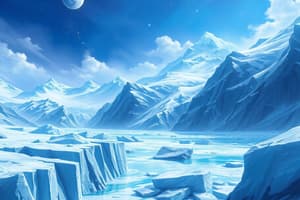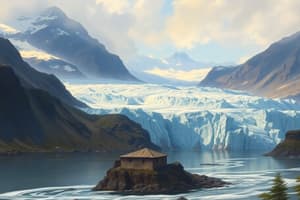Podcast
Questions and Answers
What process is primarily responsible for removing carbon dioxide from the atmosphere in the short-term cycle?
What process is primarily responsible for removing carbon dioxide from the atmosphere in the short-term cycle?
Which of the following best describes the Coriolis Effect?
Which of the following best describes the Coriolis Effect?
What characterizes a passive continental margin?
What characterizes a passive continental margin?
What is the primary cause of upwelling in ocean regions?
What is the primary cause of upwelling in ocean regions?
Signup and view all the answers
What distinguishes biogenous sediments from lithogenous sediments?
What distinguishes biogenous sediments from lithogenous sediments?
Signup and view all the answers
What characterizes the troposphere in terms of temperature as altitude increases?
What characterizes the troposphere in terms of temperature as altitude increases?
Signup and view all the answers
Which of the following statements accurately describes confined aquifers?
Which of the following statements accurately describes confined aquifers?
Signup and view all the answers
What characterizes the accumulation zone of a glacier?
What characterizes the accumulation zone of a glacier?
Signup and view all the answers
What is the primary difference between porosity and permeability in relation to rock?
What is the primary difference between porosity and permeability in relation to rock?
Signup and view all the answers
Where is the point of highest stream velocity typically found in a meander?
Where is the point of highest stream velocity typically found in a meander?
Signup and view all the answers
Which process contributes to the internal flow of a glacier?
Which process contributes to the internal flow of a glacier?
Signup and view all the answers
What are moraines?
What are moraines?
Signup and view all the answers
What type of aquifer is specifically described as having high hydrostatic pressure allowing free-flowing water?
What type of aquifer is specifically described as having high hydrostatic pressure allowing free-flowing water?
Signup and view all the answers
What is the main force that causes glaciers to move?
What is the main force that causes glaciers to move?
Signup and view all the answers
Which type of glacier is known for covering large areas of the land surface?
Which type of glacier is known for covering large areas of the land surface?
Signup and view all the answers
What distinguishes ephemeral streams from perennial streams?
What distinguishes ephemeral streams from perennial streams?
Signup and view all the answers
What percentage of Earth's fresh water is held in polar ice sheets?
What percentage of Earth's fresh water is held in polar ice sheets?
Signup and view all the answers
What is meant by glacial drift?
What is meant by glacial drift?
Signup and view all the answers
What is the primary role of the oceans in the carbon dioxide cycle?
What is the primary role of the oceans in the carbon dioxide cycle?
Signup and view all the answers
Which process involves the vertical movement of air due to temperature differences?
Which process involves the vertical movement of air due to temperature differences?
Signup and view all the answers
What type of glacier is commonly found in mountain regions?
What type of glacier is commonly found in mountain regions?
Signup and view all the answers
Which of the following describes the zone where a glacier gains mass?
Which of the following describes the zone where a glacier gains mass?
Signup and view all the answers
What percentage of the Earth's water is freshwater?
What percentage of the Earth's water is freshwater?
Signup and view all the answers
What is the primary characteristic that distinguishes confined aquifers from unconfined aquifers?
What is the primary characteristic that distinguishes confined aquifers from unconfined aquifers?
Signup and view all the answers
Which atmospheric layer is known for containing the ozone layer?
Which atmospheric layer is known for containing the ozone layer?
Signup and view all the answers
What type of landform is created by the deposition of sediments by glaciers?
What type of landform is created by the deposition of sediments by glaciers?
Signup and view all the answers
What is the primary characteristic of the stratosphere regarding temperature changes?
What is the primary characteristic of the stratosphere regarding temperature changes?
Signup and view all the answers
Which layer of the atmosphere contains the majority of the ozone?
Which layer of the atmosphere contains the majority of the ozone?
Signup and view all the answers
What happens to meteors in the mesosphere?
What happens to meteors in the mesosphere?
Signup and view all the answers
What is the primary driver of wind movement in the atmosphere?
What is the primary driver of wind movement in the atmosphere?
Signup and view all the answers
How does the albedo of Earth's surface vary with location?
How does the albedo of Earth's surface vary with location?
Signup and view all the answers
Which atmospheric layer has the least amount of atmospheric gases?
Which atmospheric layer has the least amount of atmospheric gases?
Signup and view all the answers
What are the major processes of heat transfer in the atmosphere?
What are the major processes of heat transfer in the atmosphere?
Signup and view all the answers
Which of the following is NOT a reason for the seasonal variation in ozone concentration?
Which of the following is NOT a reason for the seasonal variation in ozone concentration?
Signup and view all the answers
What role do oceans play in the carbon dioxide cycle?
What role do oceans play in the carbon dioxide cycle?
Signup and view all the answers
Which zone of a glacier is characterized by net mass gain?
Which zone of a glacier is characterized by net mass gain?
Signup and view all the answers
What is glacial till?
What is glacial till?
Signup and view all the answers
What facilitates basal sliding in glacier movement?
What facilitates basal sliding in glacier movement?
Signup and view all the answers
Which type of glacier covers large land areas, such as Greenland and Antarctica?
Which type of glacier covers large land areas, such as Greenland and Antarctica?
Signup and view all the answers
What is the primary characteristic of ephemeral streams?
What is the primary characteristic of ephemeral streams?
Signup and view all the answers
Which part of a glacier is where mass gain equals mass loss?
Which part of a glacier is where mass gain equals mass loss?
Signup and view all the answers
Where is the largest reservoir of unfrozen freshwater located?
Where is the largest reservoir of unfrozen freshwater located?
Signup and view all the answers
Study Notes
Glaciers
- Glaciers are permanent bodies of ice, formed from recrystallized snow. They move downslope due to their weight
- Parts of a glacier:
- Accumulation Zone: Highest part, snow accumulation leads to net mass gain.
- Ablation Zone: Lower part, melting exceeds accumulation, resulting in net mass loss.
- Equilibrium Line: Boundary between accumulation and ablation zones, mass gain equals mass loss.
- Glacial Movement:
- Internal Flow (Creep): Ice deforms under stress, creating crevasses.
- Basal Sliding: Meltwater reduces friction, facilitating glacier movement.
- Glacial Erosion and Deposits:
- Glacial Drift: All sediment moved and deposited by glaciers.
- Till: Unsorted glacial drift, deposited directly from ice.
- Moraines: Till deposits, categorized by location (lateral, medial, terminal).
- Types of Glaciers:
- Continental Glaciers (Ice Sheets): Large ice sheets covering land (e.g., Greenland, Antarctica).
- Mountain Glaciers (Alpine, Cirque, Valley): Various types found in mountainous regions.
Hydrologic Cycle
- Water Distribution:
- Oceans contain over 97.5% of Earth's water (mostly saline).
- Polar ice sheets hold about 74% of Earth's freshwater (frozen).
- Groundwater is the largest reservoir of unfrozen freshwater.
- Streams:
- Ephemeral Streams: Flow only after rainfall/floods, no base flow.
- Perennial Streams: Flow year-round, sustained by base flow.
- Stream Flow: Consists of storm flow (runoff) and base flow (groundwater).
- Stream Load Types:
- Bedload: Largest material dragged along the bottom.
- Suspended Load: Finer materials carried within the water.
- Dissolved Load: Ions from rock and organic matter.
- Particle Movement: Influenced by particle size, stream velocity, and density.
Porosity and Permeability
- Porosity: Percentage of a rock's volume that is open space.
- Permeability: Ease of fluid flow through a rock.
- Both factors determine how much water a material can hold and how easily water moves.
Aquifer Systems
- Unconfined Aquifers: Directly connected to the surface, with a water table.
- Confined Aquifers: Bounded above and below by impermeable layers (aquicludes).
- Artesian Aquifers: Confined aquifers with high pressure, allowing water to rise in wells.
Atmospheric Layers
-
Troposphere: Lowest layer, where weather occurs. Temperature decreases with altitude.
-
Stratosphere: Above troposphere, temperature increases with height due to ozone absorbing UV radiation. Ozone Layer is located here.
-
Mesosphere: Temperature decreases with height. Meteors often burn up in this layer.
-
Thermosphere: Temperature increases with altitude due to absorption of high energy solar radiation.
-
Atmospheric Processes:
- Temperature Changes: Generally decrease with altitude in the troposphere but increase in the stratosphere, leading to distinct layers.
- Ozone Layer: Absorbs most of the sun's harmful ultraviolet radiation, vital for life on Earth.
- Pressure and Wind: Driven by pressure differences, influenced by temperature differences, Earth's rotation (Coriolis effect).
- Albedo: The reflectivity of Earth's surface, affects how much solar radiation is absorbed (higher at poles due to ice).
- Heat Transfer: Convection, Conduction, Radiation.
Heat Transfer
- Convection: Vertical movement of air due to temperature differences.
- Conduction: Direct transfer of heat between molecules.
- Radiation: Transfer of energy through electromagnetic waves.
- Affects the amount of solar radiation absorbed by Earth's surface.
Oceans
- Key Features: Continental margins (passive vs. active), abyssal plains, trenches, mid-ocean ridges.
- Sediments: Lithogenous, biogenous, hydrogenous.
- Circulation: Surface currents, driven by winds and influenced by Coriolis effect. Thermohaline circulation (global conveyor belt).
- Upwelling: Nutrient-rich water rises to the surface.
- El Niño and La Niña: Affect trade winds and upwelling patterns in the Pacific Ocean.
Atmosphere Key Processes
- Solar radiation: Shortwave vs. Longwave
- Albedo: Reflectivity of surfaces, ice has high albedo
- Heat transfer: Includes Conduction, Convection and Radiation (transfer of energy through electromagnetic waves)
- Pressure and wind: Coriolis effect; Influence on weather patterns.
- Jet streams: High-speed air currents, influence weather patterns
- Key Atmospheric Processes:
- Albedo: Reflectivity of surfaces (e.g., ice has high albedo and reflects more solar energy)..
Carbon Dioxide Cycle
- CO2 is a greenhouse gas.
- Oceans play a significant role in absorbing atmospheric CO2.
- CO2 is incorporated into marine organisms and carbonate shells.
Studying That Suits You
Use AI to generate personalized quizzes and flashcards to suit your learning preferences.
Related Documents
Description
Test your knowledge on critical Earth science concepts, including the processes responsible for removing carbon dioxide, the characteristics of different sediment types, and the dynamics of glaciers and aquifers. This quiz covers various fundamental aspects of atmospheric and oceanic sciences.




